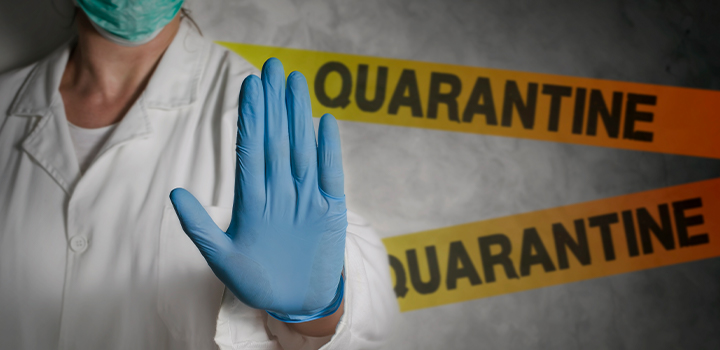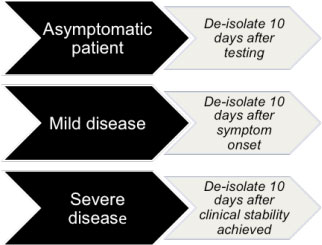Latest guidelines on COVID-19 'self-quarantine' and 'self-isolation' explained

When a test shows you have COVID-19, do you self-isolate for 14 or 10 days? And how long do you self-quarantine for after being exposed to (having had close contact with) a person confirmed to have COVID-19? Here's clarity on the latest guidelines.
On 17 July, Minister of Health Dr Zwelini Mkhize announced a reduction in the self-isolation period recommended for people who test positive for COVID-19 (a test shows they have COVID-19), from 14 to 10 days. It's very important that we all understand what this means.
First, we need to understand what it means to 'self-isolate' or 'self-quarantine' and what the difference is.
It's highly likely that in the weeks and months to come, we will experience the need to self-isolate or self-quarantine at home as a result of COVID-19 infection or exposure.
What's the difference between self-isolation and self-quarantine?
Here's a reminder of the difference between the two methods of limiting contact with others:
- Self-isolation
Self-isolation is what is required if you develop symptoms of COVID-19 or a test shows you have the disease. We self-isolate to stay away from others and avoid passing the disease on to them. You can self-isolate at home or in a dedicated self-isolation facility if you are not very sick. If you're sick enough to require admission to hospital, you can also isolate in a hospital. How long must we self-isolate for? This depends on how ill you are. We explain this in the next section of this article. - Self-quarantine
Self-Quarantine happens when we have had a high risk exposure to COVID-19. (High-risk exposure means you have had direct, close contact for more than 15 minutes with someone who tests positive for COVID-19, and you did not wear protective cloth face masks or you had physical contact or took other risks that could have exposed you to the COVID-19 virus). In this case, self-quarantine is recommended for 14 days (we separate ourselves from others in the same way as when isolating). During this time, you should monitor for symptoms of COVID 19.
If you develop symptoms of COVID-19 , you should contact a healthcare professional who will guide you through the testing process. There is no need to test for COVID-19 during your self-quarantine period UNLESS you develop symptoms. If you test without having symptoms, you could get incorrect results (a false negative) as the disease can still be in the incubation period. In this case, a negative test does not mean you do not have COVID-19.
If you test positive, you would then move from self-quarantine to self-isolation as we explained. If you develop symptoms during this self-quarantine period, you need to isolate for 10 days starting from the day your symptoms began.
What's similar between self-isolation and self-quarantine?
Both self-isolation and self-quarantine mean separating ourselves from others by staying home (not going out to the shops or being in any other situation where we encounter other people). Within our homes, it means we make every effort to stay away from others in the household and avoid using common areas. During this time, we wear masks at all times while interacting with others in the home, frequently wash our hands with soap and water or with alcohol based hand sanitisers if soap and water is not available as well as cleaning and disinfecting all frequently touched objects and commonly used spaces.
Why did the self-isolation period change from 14 to 10 days?
What did Minister of Health Dr Zwelini Mkhize mean when he recently announced a reduction in the self-isolation period recommended for people who have tested positive for COVID 19 from 14 to 10 days?
The following figure summarises the revised recommendations :

Self-isolation
Minister Mkhize explains that this recommendation is based on evidence that most patients with a mild COVID 19 infection continue to shed the virus from their upper airways for approximately 7 to 12 days. However, shedding the virus does not necessarily imply infectiousness. It has been found that in mild cases, the virus generally remains viable for 8 to 9 days after symptoms start.
How long you have to be in self-isolation depends on how serious your symptoms are:
- People who have no symptoms of COVID-19 but who have tested positive must remain in self-isolation for 10 days after they get their test results. This is because the fact that they are asymptomatic makes it difficult to estimate where they are in their disease process and how much viral shedding was taking place at the time when they tested positive.
- People who have a mild case of COVID-19 need to isolate for 10 days from the day their symptoms start. (The recommendation was initially self-isolation for 14 days).
- People who have a severe COVID-19 infection should they end their self-isolation 10 days after they have been declared clinically stable (and not 10 days after symptoms started as in with mild cases of COVID-19). In other words, 10 days after they are no longer on any oxygen supplementation.
Self-quarantine
People who have had close contact with a COVID-19 positive person but not yet developed symptoms or tested positive, should self-quarantine for 14 days - the guidelines in this regard have not changed.
It is not recommended that those considered as close contacts undergo testing for COVID-19 as they risk a false negative result if they test too early. It is best practice to only test if symptoms become evident.
Read the Minister's statement in full.
What is the expected recovery times for a 'mild', 'moderate' or 'severe' bout of COVID-19?
As the new guidelines refer explicitly to different severities of illness, it's important that we understand what to expect in terms of recovery for each.
According to the National Institute for Communicable Diseases, the following definitions apply to each experience of COVID-19 as well as to what we can expect from the recovery period:
- Mild COVID-19 illness: About 80% of people who are infected with COVID-19 will either be completely asymptomatic or experience mild symptoms. Someone with mild symptoms will recover within a week to 10 days. If you are experiencing mild illness you should expect the recovery process to be similar to that of other significant respiratory viral infections such as the flu.
- Moderate COVID-19 illness: This form of COVID-19 sees people experience more acute or alarming symptoms that warrant a visit to an emergency room or even admission to hospital. The recovery process is lengthier than for those with milder symptoms and we can expect a prolonged (several weeks) experience of fatigue, coughing and shortness of breath along with other symptoms (which can vary from person to person).
- Severe COVID-19 illness: This form of COVID-19 may see a person need treatment in an intensive-care unit (ICU) and possibly be on a ventilator. It will then take anywhere from several weeks to months to recover as it can take time for affected body systems to return to full strength. For example, if the lungs have been affected, how much time is needed to return to normal function will depend on how much strength a person has lost and how much damage has been done to their lungs. COVID-19 can affect multiple body systems.
ALL MEDICAL INFORMATION FOUND ON THIS WEBSITE INCLUDING CONTENT, GRAPHICS AND IMAGES, IS FOR EDUCATIONAL AND INFORMATIONAL OBJECTIVES ONLY. DISCOVERY HEALTH PUBLISHES THIS CONTENT TO HELP TO PROTECT AND EMPOWER ALL SOUTH AFRICANS BY PROMOTING A BETTER UNDERSTANDING OF COVID-19.
Find a healthcare professional near you
Find a doctor or hospital near you online or by using the Discovery app.